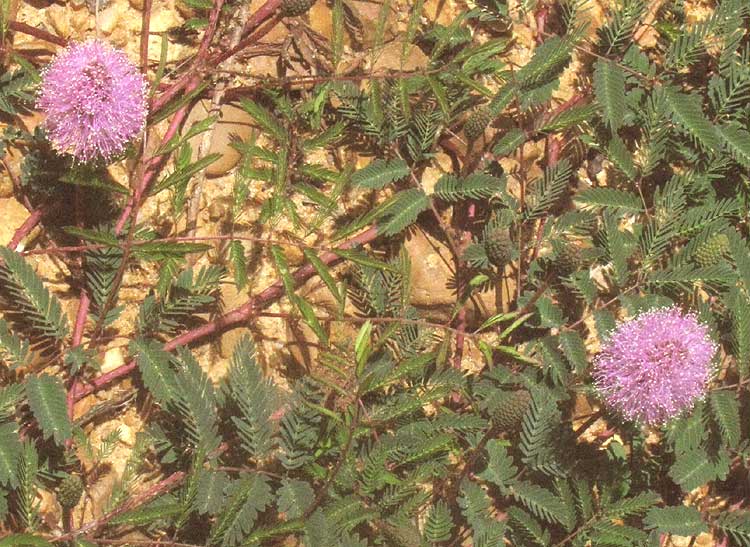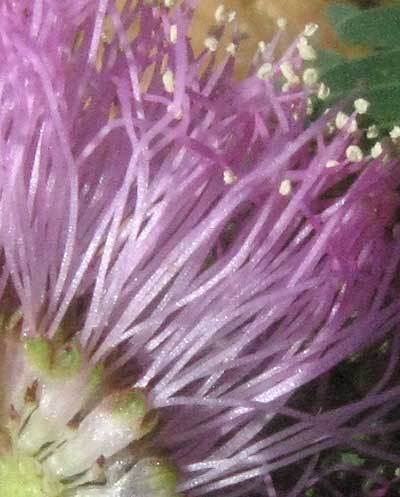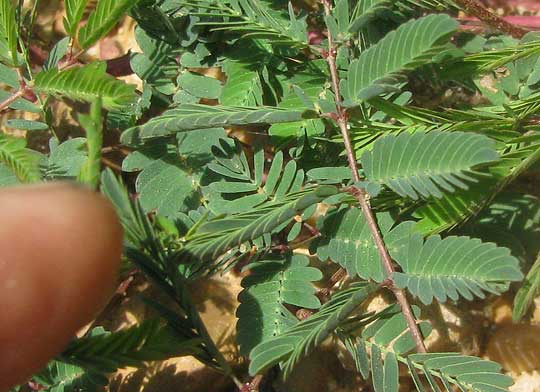Excerpts from Jim Conrad's
Naturalist Newsletter

from the the June 24, 2012 Newsletter issued from the woods of the Loess Hill Region a few miles east of Natchez, Mississippi, USA
SENSITIVE-BRIAR FLOWERING
As I biked down the long, very hot, sunlight-bedazzled gravel road through nearby Homochitto National Forest, at the road's sandy edge there was a low mat of ferny herbage sprouting from a crisscrossing network of ground-hugging, reddish, stickery stems. The patch was about the size of a bathtub. Here and there pink, golfball-sized, pompom-like flowering heads rose above the leaves. That's a small section of the plant above.
The temperature was so high that when I dismounted the bike and no longer had cooling air flowing around me, I almost lost my breath. How could such a tender-looking little plant survive hugging the sand and gravel, with the sun's full force at midday coming down on it?
It was the Eastern Sensitive-briar, MIMOSA MICROPHYLLA, a native wildflower so tough and flexible that when humans began destroying North America's Eastern Forest Biome it was able to expand from its ecological bases in sandhills, hammocks and open woods into abandoned, soil-impoverished fields, roadsides and even derelict city lots.
Sensitive-briars are members of the huge Bean Family, and the Mimosa subfamily. The pink pompoms are not flowers, but rather flower heads, or inflorescences. A cross section of a head showing what's going on with the flowers is shown below:

Bases of three or so actual flowers can be seen packed next to one another. From inside the corolla of each flower arise 8-10 stamens with pink filaments and tiny, whitish, pollen-producing anthers. This is all typical of the genus Mimosa and its subfamily, which also includes the acacias and Silk Trees we've looked at lately. What's extraordinary about sensitive-briars is that they're sensitive. Touch their leaves and immediately they fold. You can see part of one of this plant's twice-compound leaves, with leaflets on the left closed only two or three seconds after I had touched them with my finger, and untouched leaflets of the right still open, below:

Usually it takes 3-5 minutes for the leaves to open back up. In Plant Physiology class we were taught how the movement resulted when touch disrupted a finely balanced system of water pressure in the plant, but I never found that explanation entirely convincing. And now I'm gratified to find that the specialists still disagree as to why sensitive plants are touch sensitive to begin with. Some say it's to make the plant less visible to herbivores; others say the movement better exposes the stems' spines so they can better protect the plant; others say closed leaves cause the plant to look sick to herbivores, who know better than to eat sick-looking plants; others say that merely seeing a plant move unnerves herbivores, who then go eat less demonstrative plants. Who knows?
I know it was wonderful to meet such a remarkable plant so pleasingly sitting along that isolated, inhospitable road, minding its business photosynthesizing oxygen for me to breathe, providing nectar for pollinators, reclaiming a roadside for the forces of Life on Earth, and even putting on a show for anyone willing to poke a leaf.